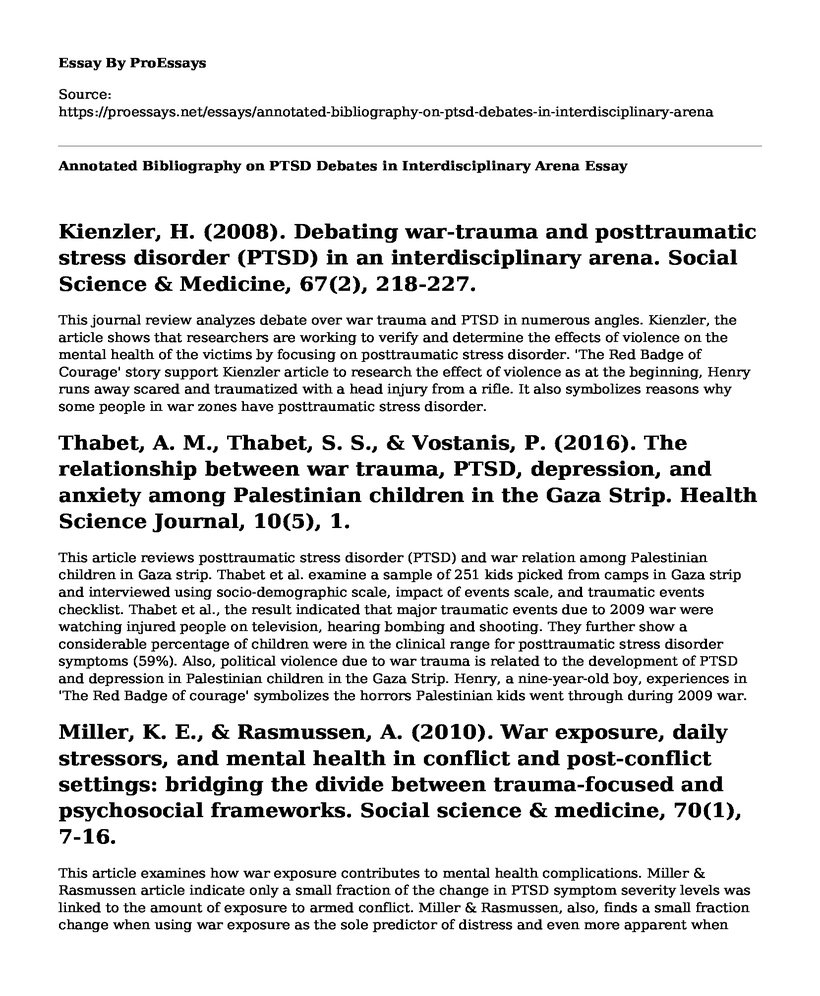Kienzler, H. (2008). Debating war-trauma and posttraumatic stress disorder (PTSD) in an interdisciplinary arena. Social Science & Medicine, 67(2), 218-227.
This journal review analyzes debate over war trauma and PTSD in numerous angles. Kienzler, the article shows that researchers are working to verify and determine the effects of violence on the mental health of the victims by focusing on posttraumatic stress disorder. 'The Red Badge of Courage' story support Kienzler article to research the effect of violence as at the beginning, Henry runs away scared and traumatized with a head injury from a rifle. It also symbolizes reasons why some people in war zones have posttraumatic stress disorder.
Thabet, A. M., Thabet, S. S., & Vostanis, P. (2016). The relationship between war trauma, PTSD, depression, and anxiety among Palestinian children in the Gaza Strip. Health Science Journal, 10(5), 1.
This article reviews posttraumatic stress disorder (PTSD) and war relation among Palestinian children in Gaza strip. Thabet et al. examine a sample of 251 kids picked from camps in Gaza strip and interviewed using socio-demographic scale, impact of events scale, and traumatic events checklist. Thabet et al., the result indicated that major traumatic events due to 2009 war were watching injured people on television, hearing bombing and shooting. They further show a considerable percentage of children were in the clinical range for posttraumatic stress disorder symptoms (59%). Also, political violence due to war trauma is related to the development of PTSD and depression in Palestinian children in the Gaza Strip. Henry, a nine-year-old boy, experiences in 'The Red Badge of courage' symbolizes the horrors Palestinian kids went through during 2009 war.
Miller, K. E., & Rasmussen, A. (2010). War exposure, daily stressors, and mental health in conflict and post-conflict settings: bridging the divide between trauma-focused and psychosocial frameworks. Social science & medicine, 70(1), 7-16.
This article examines how war exposure contributes to mental health complications. Miller & Rasmussen article indicate only a small fraction of the change in PTSD symptom severity levels was linked to the amount of exposure to armed conflict. Miller & Rasmussen, also, finds a small fraction change when using war exposure as the sole predictor of distress and even more apparent when results other than PTSD are used as variables. For example, Henry in 'The Red Badge of Courage' at the end of the war, emerged a reliable soldier. He is, therefore, supporting Miller & Rasmussen article that other factors other than war can accelerate PTSD symptoms.
References
Kienzler, H. (2008). Debating war-trauma and posttraumatic stress disorder (PTSD) in an interdisciplinary arena. Social Science & Medicine, 67(2), 218-227.
Miller, K. E., & Rasmussen, A. (2010). War exposure, daily stressors, and mental health in conflict and post-conflict settings: bridging the divide between trauma-focused and psychosocial frameworks. Social science & medicine, 70(1), 7-16.
Thabet, A. M., Thabet, S. S., & Vostanis, P. (2016). The relationship between war trauma, PTSD, depression, and anxiety among Palestinian children in the Gaza Strip. Health Science Journal, 10(5), 1.
Cite this page
Annotated Bibliography on PTSD Debates in Interdisciplinary Arena. (2023, Jan 29). Retrieved from https://proessays.net/essays/annotated-bibliography-on-ptsd-debates-in-interdisciplinary-arena
If you are the original author of this essay and no longer wish to have it published on the ProEssays website, please click below to request its removal:
- Effectiveness of Public Awareness Education in Reducing Stigma in the UK Paper Example
- Chronic Back Pain, PTSD and MDD Treatment Plan Paper Example
- Research Paper on Autism: A Complex Developmental Disorder
- Stigma & Mental Illness: Impacts & Discrimination - Essay Sample
- Essay Sample on Professional Commitment: A Sense of Responsibility
- Free Essay Sample on Precede-Proceed Model: Transforming Health Solutions Worldwide
- Stress and Resilience in the Work Place - Essay Sample







